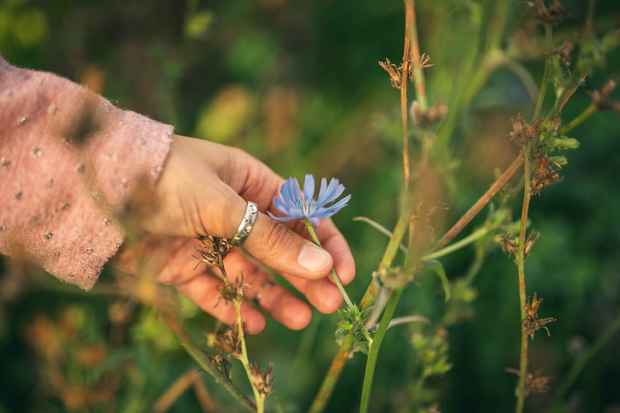Medicine Gardener & Four Season of Foraging BUNDLE
Medicine Gardener Online Course
Growing your own food and medicine is so empowering for you and your family! Most medicinal herbs origins are of wild plants that grew without any tending too, unlike many of our vegetable crops. Therefore, they have very individual growing needs. Some are quite easy to grow while others require a lot more attention and specific growing conditions as well as optimal harvest times.
In this course, you will learn how to design & build a medicinal herb garden using sustainable, regenerative gardening practices such as Permaculture & Biodynamics. There will be focus on cultivating healthy soils, that will in turn cultivate healthy plants and help maintain soil vitality. Knowing which tools of the trade you need is another important aspect of successfully growing and harvesting your own medicine so this will be addressed as well.
How do you know which medicinal herbs you want to grow? Do you want to grow a mix of culinary and medicinal herbs, do you want to grow a children’s herb garden, do you want to grow an apothecary garden? This course will help you decide which herbs you want to (and can) grow in your medicinal garden. There will be 19 growing & harvesting plant profiles for you to use to help make your selections however other plants will be discussed throughout the course. The following plants will be discussed: Anise Hyssop, Ashwagandha, Bee Balm, Borage, Calendula, California Poppy, Chamomile, Echinacea, Garlic, Hyssop, Lavender, Lemon Balm, Marshmallow, Motherwort, Oats, Peppermint, Sage, Stinging Nettle & Thyme.
Once you have chosen the plants you want to grow in your medicine garden you will then need to start these plants from seed or buy transplants. There are many different seed germination treatments to consider with medicine herb seeds which will be covered in the course as well as what to look for when buying transplants. We will touch on potting soils and companion planting.
Maintaining your garden throughout the season is a delightful experience as you watch the plant grow from a seed into a beautiful plant that attracts the buzzing bee with its lovely flowers. There are certain plants that will attract pollinators as well as control pests naturally which we will discuss as well as weed control.
All medicinal herbs have specific parts of the plant that we harvest for medicine and this needs to be done at specific times throughout the growing cycle. We will discuss this in depth for each plant part as well as how to properly store your herbs once they have been harvested.
And then another growing season is done and its time to put our garden to bed. There are a few things we can do to ensure a nice garden bed to start the next growing season.
Four Seasons of Foraging Online Course
Learning the nutritional and medicinal benefits of the plants that are growing around you is empowering! Enjoy this journey as you learn to live harmoniously with nature through the seasons.
In this course you will learn the following:
Categories of Herbs- Nourishing, Tonifying, Stimulating/Sedating & Potentially Poisonous
Introduction to Herbalism- Herb Actions, Chemistry of Herbs, What is a Materia Medica, Herbal Allies, Doctrine of Signatures
Foraging (Wildcrafting) & Harvesting- Introduction to Foraging, Ethical Harvesting, Tools of the Trade, Gathering & Drying Herbs, Living in Harmony with the Seasons
Basic Botany- Herb Botany Terms, Plant Components, Plant Families, Components of an Ecosystem (Fungi, Algae, Lichen)
Medicine Making- Creating a Home Apothecary, Tea, Tisane & Infusion, Nourishing Herbal Infusions, Decoctions, Herbal Syrups, Intro to Extractions, Tinctures, Glycerites, Intro to Herb Infused Oils, Herb Infused Oil Preparations Methods, Salves & Lip Balms, Herb Vinegars, Herb Honey, Oxymel & Flower Essences
Spring Trees- Alder, Aspen, Birch, Elder, Pine, Spruce, Witch Hazel
Spring Plants- Chickweed, Coltsfoot, Dandelion, Horsetail, Nettle, Plantain, Red Clover, Rose, Violet, Yarrow
Summer Plants- Linden, Boneset, Eyebright, Goldenrod, Meadowsweet, Mugwort, Mullein, Partridge Berry, Pearly Everlasting, Red Raspberry, Self-Heal, Skullcap, St. John's Wort, Wild Chamomile, Wintergreen, Wild Lettuce
Fall Trees- Hawthorn, High Bush Cranberry/Crampbark
Fall Plants- Burdock, Valerian, Wild Sarsaparilla, Yellow Dock
Winter Tree- Cedar, Balsam Poplar
Winter Lichen- Usnea
Winter Medicinal Mushroom- Chaga
Wild Plants in NB: Foraging Local Food Lecture
This courses are delivered online with PDF downloadable documents as well as videos.
You will be able to access the material as well as the ability to email the instructor at any time.
